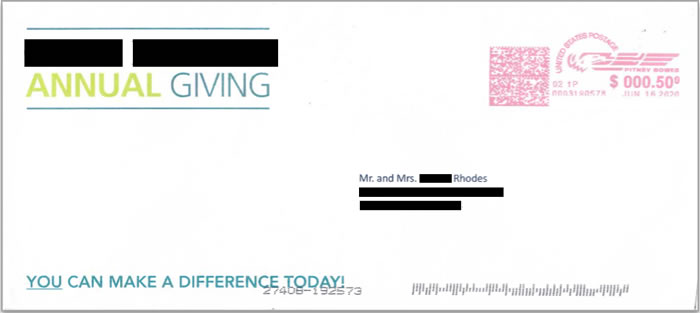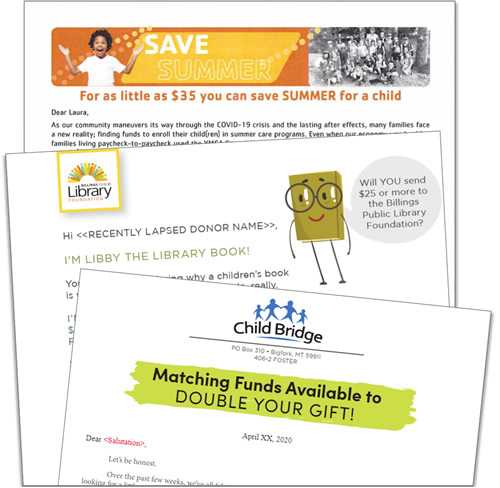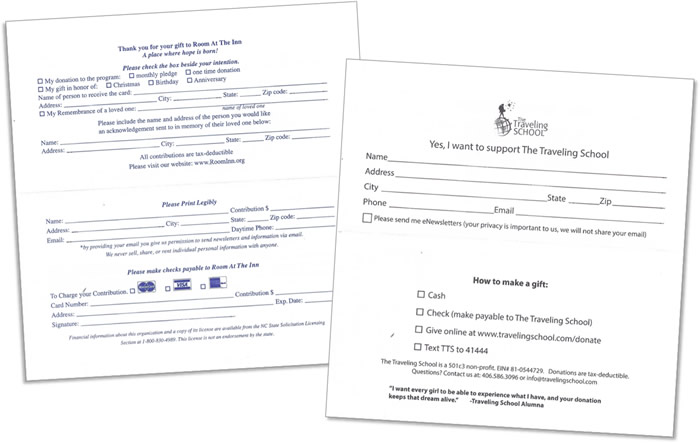Before you sit down to write your next fundraising letter, think about this.
It's more than a "letter" - it's a package.
Yet there are key elements that many nonprofits overlook when writing their appeals and putting their package together.
I've written before about
small things that can make a big difference in your fundraising letters.
This post will look at four more things that can make an even bigger difference in your campaign results this year.
THE OUTER ENVELOPE
Do you know the purpose of your fundraising letter's outer envelope?
It's not simply to deliver the letter. It's to get someone to open your letter.
Yet far too many nonprofits pay too little attention to this attention-getting piece of the package.
Consider this. Just last month, I received an appeal letter. The envelope made it very clear this was a fundraising campaign.

I wonder how many people didn't open that envelope, simply because they knew it was a solicitation from the get-go? I'd bet a lot.
Think about it this way. If someone doesn't open your letter, they're not going to read it.
And if they don't read it, they aren't going to give.
THE JOHNSON BOX
Here's a sad, but true, fact. Most donors - the ones who actually do open your mail - aren't reading what you wrote.
Today, a human's
attention span is shorter than a goldfish's.
That means, a donor is "reading" your letter in less than 10 seconds. In that time, she's deciding whether or not to give.
So, how can you get your key message across in 10 seconds or less? Enter the Johnson Box.
It's named after a direct marketer named Frank Johnson who doesn't claim to have created it - only to have popularized it in the 1960s.
Here's how it works. It's a sentence, or even a short paragraph, before the letter's salutation that delivers the
key offer.
Think of it like this: your audience only needs to read that one message to understand what you want them to do, why they should, or both.
Sometimes, that message offset in a box (hence, the Johnson "Box"). But you're not limited to that design.

THE POST SCRIPT (P.S.)
Not only will donors read what's in the Johnson Box, they'll also read what's in the post script.
In fact, more than 90% of people will read the P.S., even if they don't read anything else.
That means your post script should reinforce your letter's key message. Not introduce something new.
For instance, if you have a gift match, you might tell the donor, "P.S. Use the enclosed envelope to send your donation today. When you make your gift by December 31st, it will be matched! Your donation does twice as much good!"
That's a simple example, but it's a perfectly clear message that tells the donor exactly what you want her to do, when, and why.
And, just as there are no hard and fast design rules on the Johnson Box, there are no firm design rules on the P.S.
Your post script can be a sentence. It can be two sentences. It can be an entire paragraph. Even two paragraphs. Or more!
THE REPLY ENVELOPE / DEVICE
Just like the outer envelope, the reply envelope/device serves a specific purpose: to make it easy for your donor to return her gift.
Yet too many nonprofits make it far too difficult for a donor to give.
How? With pre-printed, self-mailer envelopes with too much text, too many choices, and not enough room to write.
As you're designing your reply device, ask yourself, "Could my grandmother easily fill this out?" (A typical donor in the U.S. is a woman, somewhere between 69 and 73 years old.)
If the answer is no, it's time to revisit your reply device.
The examples below are both self-mailers. Which one would Grandma find easier to use?

A newer trend is towards full-size reply cards. I first heard about this concept from John Lepp and Jen Love, Agents of Good.
In his book, Creative Deviations, John Lepp muses "I always wonder if we are going out of our way to make our donors feel old... Using small type means they can't easily read it." And all those teeny tiny boxes? "How they are supposed to provide their credit card number, which can hurt their hands if they have arthritis?"
HOW YOU CAN USE THIS INFORMATION
Oddly enough, writing a fundraising appeal isn't just about writing the letter.
Think of your appeal as a package, complete with an outer envelope, a reply device and, yes, your letter.
Far too many nonprofits spend too much time on the body copy of the letter. They neglect other key elements, even within the letter itself.
Your most critical letter copy is in the post script. People will read the P.S. 9 times out of 10. Use the P.S. to tell your donor what you want her to do, why, and by when.
Also, add a Johnson Box at the top of your letter. You'll get a better response when donors can quickly understand exactly what you want them to do. Right from the start.
Of course, whether or not a donor gives also assumes that she can easily complete and return your reply device.
And that assumes she actually opens your outer envelope.
Remember, your appeal is a package. You need to consider and design all of the pieces carefully.
When you do, you'll see a big difference in your campaign results.
Photo credit(s): Unsplash
Need help writing a better fundraising letter and creating a compelling campaign package? Laura Rhodes can help.
Send a message to start the conversation and learn how Laura can help you and your organization.
You may also be interested in
upcoming training events.